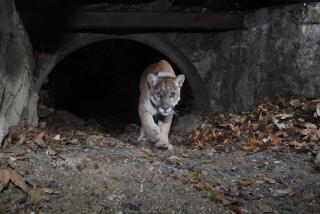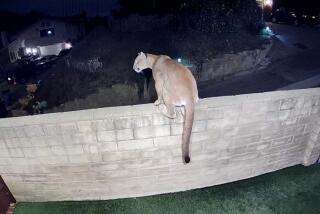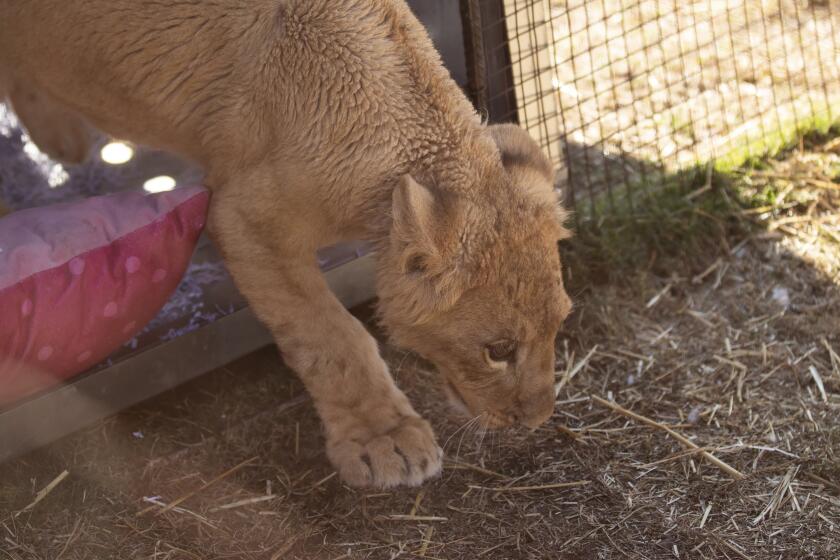Hello, P-95! Young male mountain lion tagged by biologists in Santa Monica Mountains

The biologists learned of their latest target — a mountain lion waiting to be tagged with a GPS radio collar — by text. Sent by a cage. In the Santa Monica Mountains.
Lured by the meat of roadkill deer, the young male entered the trap and when the cage door slid shut, it triggered a text message that sent biologists to the scene on the night of Jan. 17.
This new addition, named P-95, brings the number of mountain lions being tracked in Los Angeles County by the National Parks Service to 10.
Jeff Sikich, a biologist with the Santa Monica Mountains National Recreation Area, is reluctant to give too many details about how the cougars are located.
The team scopes out a possible area with remote cameras, he said. When they see a lion, they try to capture it for tagging.
Once they reach the cat, it is tranquilized. Scientists have roughly an hour to attach the collar, take physical measurements, check the animal’s general health, tag the ear, and collect blood and tissue samples.
P-95 weighed in at 90 pounds and is about 1-1/2 years old. The biologists determined he was in good condition after examining him “from the bottom of his paws to the teeth in his head,” then released him, according to a Facebook post from the Santa Monica Mountains National Recreation Area.
While they were working, they heard chirping noises and later spotted another big cat — likely the young lion’s mother or sibling, Sikich said.
“Mountain lions in general aren’t that vocal but they will communicate when a mom is with her kittens, or siblings with each other,” he said.
P-95 joins nine other mountain lions being tracked. Seven, including P-95, roam the Santa Monica Mountains and two are in the Simi Hills. The infamous P-22, who lives in Griffith Park, once hid out in the crawl space of a Los Feliz home and is suspected of killing a koala at the Los Angeles Zoo.
Since 2002, scientists have tagged almost 100 mountain lions to better understand how they engage with their habitat, though many have died or had their collars drop off.
The collars are programmed to transmit location data eight times a day: every two hours between 5 p.m. and 5 a.m., and once at 1 p.m., though scientists can remotely change individual collars to collect more specific data.
Mountain lions are most active at dawn and dusk patrolling their territory.
“We don’t know exactly what they’re doing,” Sikich said. “They’re super secretive animals.”
The geo-coordinates help scientists visualize mountain lion movement, map their home ranges and habitat preferences, and pinpoint where they get thwarted.
“You can see it in the GPS collars,” Sikich said. “The 101 [Freeway] is such a formidable barrier that most animals don’t attempt to cross it.”
Sikich described the Santa Monica Mountains as “an island of habitat” confined to the south by the ocean, north and east by freeways, and west by agricultural fields.
Mountain lions are solitary animals that need space. Sikich estimates that the Santa Monica Mountains have room for about two or three fully grown males, six adult females, and two to seven young adults that are old enough to leave their mothers but have not yet established a home range.
“Many animals are not leaving the Santa Monica Mountains and aren’t crossing the freeway,” Sikich said.
Those that do risk being killed.
And with limited territory to roam, they are at risk for inbreeding.
Lions in the Santa Monica Mountains, along with those in Orange County’s Santa Ana Mountains, have some of the lowest genetic diversity in puma populations outside the Florida panther, which nearly went extinct for lack of genetic variation until biologists introduced eight female pumas from Texas into the habitat.
A team led by Sikich recently found three mountain lions with similar kinked tails and one of the cats had only one descended testicle, indicating a lack of genetic diversity.
By tracking location data, scientists can pinpoint where to build freeway overpasses to safely facilitate movement.
The collars also help biologists study behavior. Clustered location data likely means that a mountain lion is returning to the spot where it has hidden its prey, usually deer that it will consume over the course of several nights.
And the trackers tell whether the lions are still alive. If a collar’s location hasn’t changed for 12 hours, Sikich and his colleagues will hike out to the last known location to look for a dead puma and, if found, bring it back for a necropsy.
“It’s important to know how the animals died,” Sikich said. In six cases, they found the presence of anticoagulants from rat poison, which caused uncontrolled internal bleeding.
In September, Gov. Gavin Newsom signed a bill banning the use of the rodenticide to protect mountain lions and other animals, including pets.
More to Read
Start your day right
Sign up for Essential California for news, features and recommendations from the L.A. Times and beyond in your inbox six days a week.
You may occasionally receive promotional content from the Los Angeles Times.







